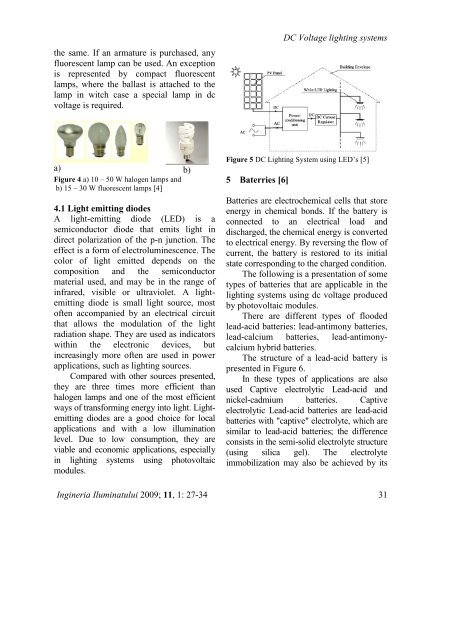ingineria iluminatului - Journal of Lighting Engineering - Prof. Florin ...
ingineria iluminatului - Journal of Lighting Engineering - Prof. Florin ...
ingineria iluminatului - Journal of Lighting Engineering - Prof. Florin ...
You also want an ePaper? Increase the reach of your titles
YUMPU automatically turns print PDFs into web optimized ePapers that Google loves.
the same. If an armature is purchased, any<br />
fluorescent lamp can be used. An exception<br />
is represented by compact fluorescent<br />
lamps, where the ballast is attached to the<br />
lamp in witch case a special lamp in dc<br />
voltage is required.<br />
a)<br />
b)<br />
Figure 4 a) 10 – 50 W halogen lamps and<br />
b) 15 – 30 W fluorescent lamps [4]<br />
4.1 Light emitting diodes<br />
A light-emitting diode (LED) is a<br />
semiconductor diode that emits light in<br />
direct polarization <strong>of</strong> the p-n junction. The<br />
effect is a form <strong>of</strong> electroluminescence. The<br />
color <strong>of</strong> light emitted depends on the<br />
composition and the semiconductor<br />
material used, and may be in the range <strong>of</strong><br />
infrared, visible or ultraviolet. A lightemitting<br />
diode is small light source, most<br />
<strong>of</strong>ten accompanied by an electrical circuit<br />
that allows the modulation <strong>of</strong> the light<br />
radiation shape. They are used as indicators<br />
within the electronic devices, but<br />
increasingly more <strong>of</strong>ten are used in power<br />
applications, such as lighting sources.<br />
Compared with other sources presented,<br />
they are three times more efficient than<br />
halogen lamps and one <strong>of</strong> the most efficient<br />
ways <strong>of</strong> transforming energy into light. Lightemitting<br />
diodes are a good choice for local<br />
applications and with a low illumination<br />
level. Due to low consumption, they are<br />
viable and economic applications, especially<br />
in lighting systems using photovoltaic<br />
modules.<br />
DC Voltage lighting systems<br />
Figure 5 DC <strong>Lighting</strong> System using LED’s [5]<br />
5 Baterries [6]<br />
Batteries are electrochemical cells that store<br />
energy in chemical bonds. If the battery is<br />
connected to an electrical load and<br />
discharged, the chemical energy is converted<br />
to electrical energy. By reversing the flow <strong>of</strong><br />
current, the battery is restored to its initial<br />
state corresponding to the charged condition.<br />
The following is a presentation <strong>of</strong> some<br />
types <strong>of</strong> batteries that are applicable in the<br />
lighting systems using dc voltage produced<br />
by photovoltaic modules.<br />
There are different types <strong>of</strong> flooded<br />
lead-acid batteries: lead-antimony batteries,<br />
lead-calcium batteries, lead-antimonycalcium<br />
hybrid batteries.<br />
The structure <strong>of</strong> a lead-acid battery is<br />
presented in Figure 6.<br />
In these types <strong>of</strong> applications are also<br />
used Captive electrolytic Lead-acid and<br />
nickel-cadmium batteries. Captive<br />
electrolytic Lead-acid batteries are lead-acid<br />
batteries with "captive" electrolyte, which are<br />
similar to lead-acid batteries; the difference<br />
consists in the semi-solid electrolyte structure<br />
(using silica gel). The electrolyte<br />
immobilization may also be achieved by its<br />
Ingineria Iluminatului 2009; 11, 1: 27-34 31
















